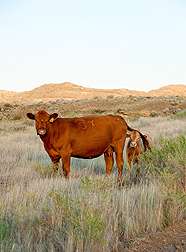Strategies developed for more efficient beef cattle production

(PhysOrg.com) -- Reducing the amount of feed given to young female cows called heifers can result in more efficient use of nutrients for growth and reproduction, according to studies conducted by U.S. Department of Agriculture (USDA) scientists.
Agricultural Research Service (ARS) animal scientist Andrew Roberts and his colleagues at the Fort Keogh Livestock and Range Research Laboratory in Miles City, Mont., found that the heifers they fed to lower target weights than those traditionally recommended consumed 27 percent less feed over the winter months, and gained weight more efficiently throughout the postweaning period and subsequent grazing season. ARS is USDA's principal intramural scientific research agency.
According to Roberts, this strategy of providing less feed may reduce costs of developing each replacement heifer by more than $31 and extend their lifespan, with important ramifications for lifetime efficiency and profitability. Feed represents 50 to 55 percent of total costs of developing replacement heifers.
In their study, begun in 2001, heifers were divided into two lifetime treatment groups: The control group was fed according to industry guidelines, and the restricted group was fed (on a body-weight basis) 80 percent of feed consumed by their control counterparts for 140 days, ending when they were 1 year old. The restricted heifers grew slower and weighed less at any point in time as a consequence of less feed. Final pregnancy rates were 87 percent for restricted heifers and 91 percent for controls.
According to Roberts, restricting feed allows nature to decide which heifers were reproductively efficient: Less efficient heifers would eventually fail to reproduce and be culled if restricted, whereas feeding more would keep them in production but result in more expense for the producer.
Read more about this research in the January 2011 issue of Agricultural Research magazine.
Provided by USDA Agricultural Research Service


















